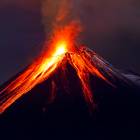Climate Solutions

Brett Jordan/Flickr
Faculty Leaders
Human activities and resource use are undeniably altering Earth’s climate, most prominently through emissions of greenhouse gases and particulates, and through alteration of the land surface. Climate change, in turn, is affecting other Earth processes, making the critical 21st-century challenges of providing food, water, and energy to a growing human population much more difficult.
Stanford Earth faculty are renowned for their research and role in the public dialogue about climate change. We work across disciplines—and at the interface of atmosphere, ocean, land, and ice systems—to characterize climate changes as well as potential responses and outcomes that matter to people.
With key faculty hires in, for example, risk analysis and the science of ice, we will be able to develop more powerful tools with which to identify appropriate responses that enable sustainable, resilient pathways for economic growth and human development with fewer unintended negative consequences.

Kevin Arrigo, the Donald and Donald M. Steel Professor in Earth Sciences and Victoria and Roger Sant Director of the Earth Systems Program, led a research team to the Arctic.

Rob Dunbar, the W. M. Keck Professor, captured his team’s arrival on the Southern Continent.
Climate Change and the Oceans
Stanford Earth faculty conduct field studies on every continent and in every ocean, including those surrounding the Arctic and Antarctica.
These oceans teem with microscopic phytoplankton, which play a very important role in the global carbon cycle. In separate studies designed to better understand climate change, Professors Kevin Arrigo and Rob Dunbar recently traveled to opposite poles to examine how shifting light, temperature, and sea ice conditions affect the productivity of the tiny marine organisms, how those changes reverberate up the food chain, and what effects they may have on the uptake of anthropogenic carbon dioxide.
Related Stories
Freeman Spogli Institute for International Studies
Stanford School of Earth, Energy & Environmental Sciences
Stanford School of Earth, Energy & Environmental Sciences
American Geophysical Union
Stanford School of Earth, Energy & Environmental Sciences
Stanford School of Earth, Energy & Environmental Sciences
Stanford School Of Earth Sciences
Stanford School Of Earth Sciences
Stanford School Of Earth Sciences
In The News
The New York Times
Los Angeles Times






















